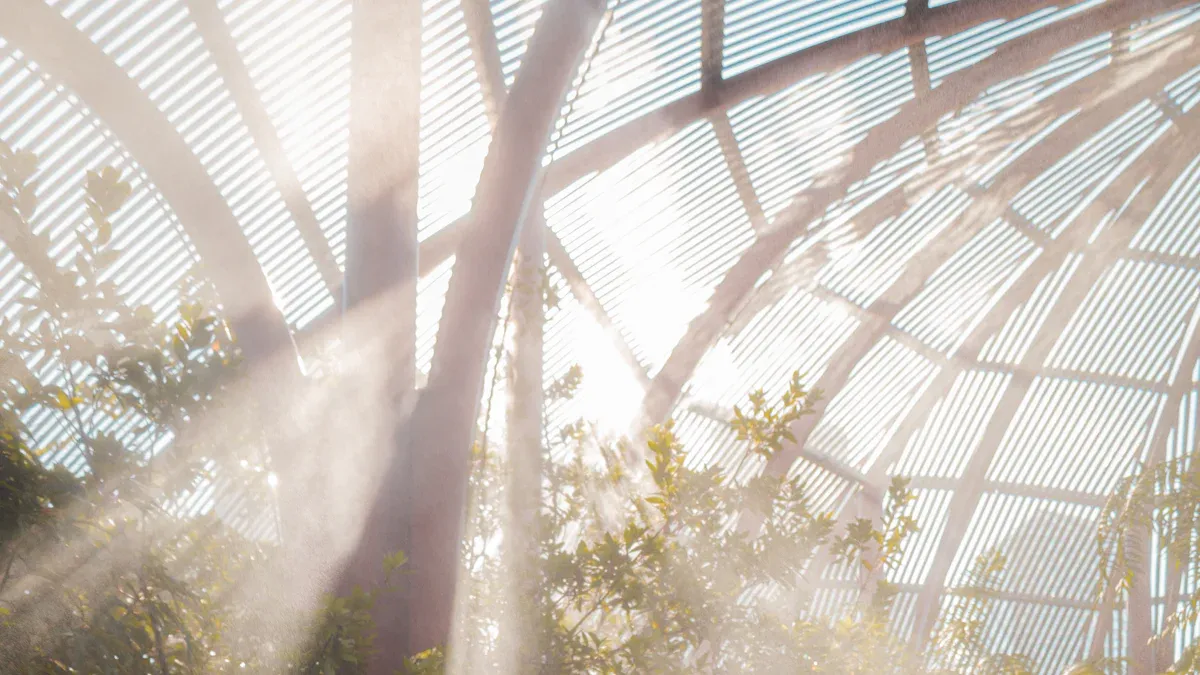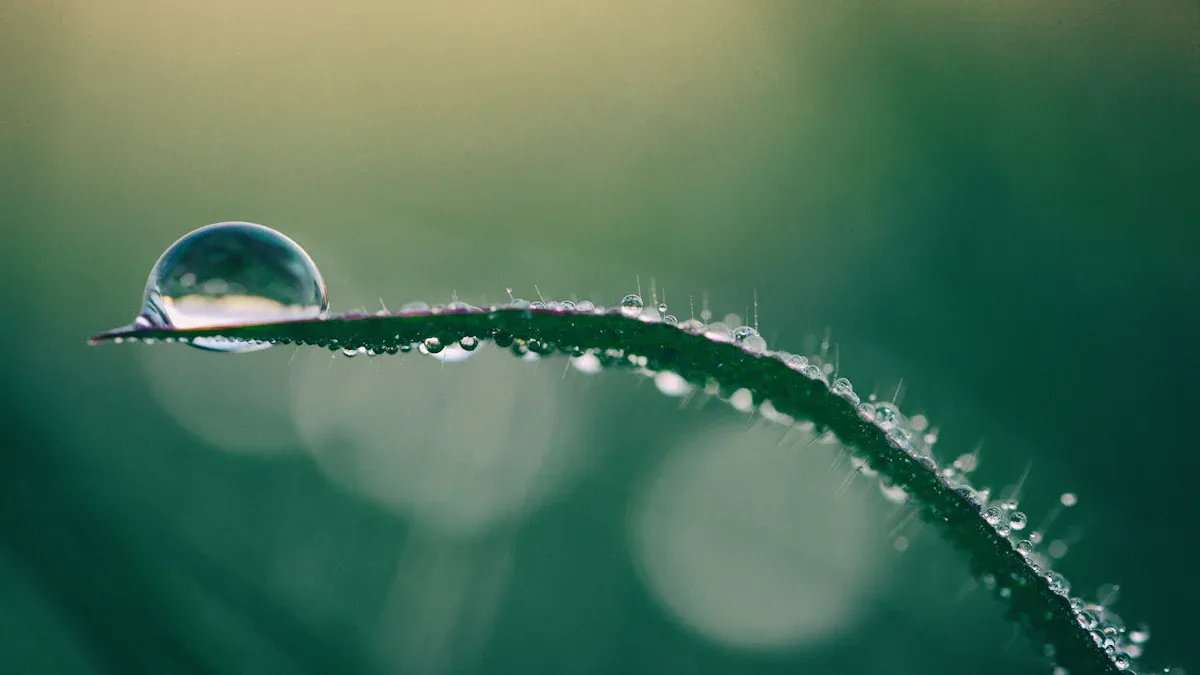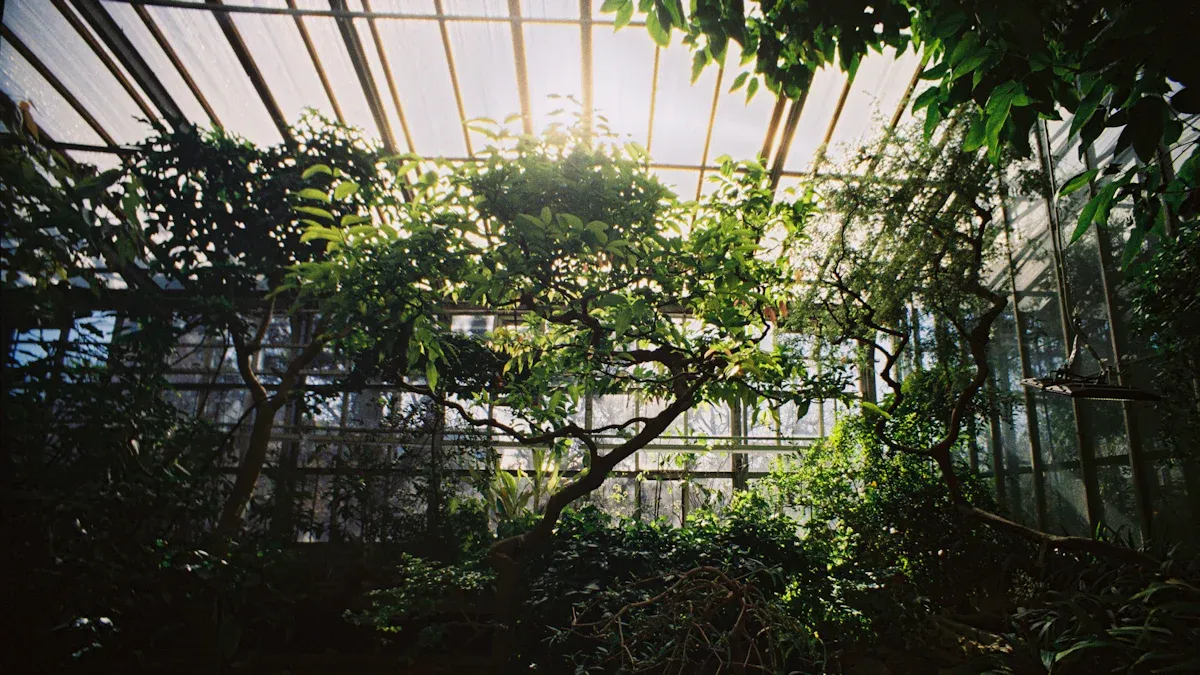
Managing sun glare in greenhouses plays a crucial role in promoting healthy plant growth. Excessive glare can hinder photosynthesis, leading to stunted growth and lower yields. You might be surprised to learn that maintaining the right light conditions can significantly impact your plants’ health. Just small adjustments can lead to remarkable improvements. For instance, keeping a consistent Daily Light Integral (DLI) is vital for optimal crop growth. Below is a summary of how managing sun glare can affect your greenhouse:
Evidence Type | Description |
|---|---|
Daily Light Integral (DLI) | The amount of photosynthetically active radiation delivered over a 24-h period, which varies daily and affects crop growth. |
Consistency of DLI | Maintaining a consistent DLI is recommended for optimal crop growth, but certain fluctuations can be tolerated. |
Economic Impact | Over 30% of the production cost for lettuce in greenhouses is attributed to energy costs associated with lighting, impacting profitability. |
DLI Carryover Effect | Higher DLIs on sunny days can compensate for lower DLIs on subsequent days, allowing for energy cost reduction in supplemental lighting. |
By understanding and managing sun glare effectively, you can create a thriving environment for your plants.
Key Takeaways
Properly orient your greenhouse to maximize sunlight exposure throughout the year.
Use shade cloth to filter sunlight and reduce glare, ensuring even light distribution for your plants.
Incorporate reflective materials to lower greenhouse heat gain while maintaining optimal light levels.
Elevate your plants using shelves or raised beds to enhance their access to sunlight.
Regularly clean greenhouse surfaces to prevent dust buildup, which can block light and hinder plant growth.
SUN GLARE EFFECTS

What is Sun Glare?
Sun glare occurs when sunlight reflects off surfaces, creating bright spots that can overwhelm your greenhouse environment. This intense light can disrupt the natural balance of light exposure that your plants need. In greenhouses, only light within the 400–700 nm wavelength range, known as photosynthetically active radiation (PAR), supports photosynthesis. Unfortunately, near-infrared light (NIR), which ranges from 780–2500 nm, doesn’t help your plants grow. Instead, it can cause overheating, with temperatures soaring up to 55 °C. Such extreme heat can be harmful, especially for crops like tomatoes, which thrive at temperatures between 20–30 °C.
Effects on Plant Health
Managing sun glare is essential for maintaining optimal conditions in your greenhouse. Excessive glare can lead to several negative effects on plant health, including:
Yellowing or whitening of leaves: This happens due to chlorophyll degradation from too much UV exposure.
Stunted or twisted growth patterns: These issues arise from cell and DNA damage, resulting in weak and malformed plants.
Reduced viability of pollen and blossom drop: Damage to reproductive health can affect seed production and fertilization.
By controlling glare, you can ensure that your plants receive the right amount of light exposure without the harmful effects of excessive sunlight. This balance is crucial for promoting healthy growth and achieving high yields. Remember, a well-managed greenhouse environment not only enhances photosynthesis but also supports overall plant health.
SHADING TECHNIQUES

Using Shade Cloth
Shade cloth is a popular choice for managing sun glare in greenhouses. It comes in various types, each with unique benefits. Here’s a quick overview of some effective shade cloth options:
Shade Cloth Type | Benefits | Best For |
|---|---|---|
Black Shade Cloth | Absorbs sun energy, increases temperature, prevents sunscald | Northern growers in spring and fall |
White Shade Cloth | Allows maximum light transmission, speeds up growth | Southern growers in peak summer |
Aluminum Netting | Improves light diffusion and temperature regulation | Various growing conditions |
Using shade cloth helps you control the amount of sunlight your plants receive. In summer, you might want to increase shading to prevent heat stress. Conversely, during autumn and winter, consider reducing or removing shading to maximize sunlight exposure for your plants. This seasonal adjustment is crucial for optimizing growth.
Reflective Materials
Using reflective materials can also be an effective way to manage sun glare. These materials, like Svensson FLS, can reduce greenhouse heat gain by about 30% at a 60% shading level. This leads to lower leaf temperatures and enhanced plant productivity. Here are some benefits of using reflective materials compared to traditional shade cloth:
Reflective materials block light and reflect heat, creating a cooler microclimate.
Black shade cloth only reduces energy gain by 40-50%, providing minimal thermal improvement.
Reflective options help maintain optimal light levels while keeping your plants cool.
Incorporating reflective materials into your greenhouse setup can significantly improve your plants’ health and growth. You can also consider using shading compounds, which are inexpensive and effective for reflecting light before it enters the greenhouse. Additionally, installing retractable shade curtains allows you to control light and temperature precisely, improving crop quality.
By exploring these shading techniques, you can create a more balanced environment for your plants, ensuring they thrive throughout the year.
MAXIMIZE SUNLIGHT
Positioning the Greenhouse
To truly maximize sunlight in your greenhouse, positioning is key. You want to orient your greenhouse to capture as much natural sunlight as possible. A north-south orientation works wonders during the summer. This layout allows sunlight to hit both sides of your plant rows evenly, promoting balanced growth. In winter, consider an east-west orientation. This setup captures more midday sunlight, giving your plants the extra light and warmth they need during colder months.
Here are some best practices for positioning your greenhouse:
Orientation: Aim for a north-south layout for balanced sunlight year-round.
Avoid Shading: Keep your greenhouse free from shadows cast by nearby structures.
Consider the Sun’s Path: Position it to capture maximum light, especially in winter.
Wind Protection: Use windbreaks to shield your greenhouse from strong winds without causing shading.
Accessibility: Place it near water sources for convenience.
By following these tips, you can create an efficient greenhouse layout that maximizes sunlight exposure while minimizing glare.
Elevating Plants
Elevating your plants can also help you maximize sunlight. When you raise your plants, you allow them to receive more direct light, especially if your greenhouse has limited height. Here are a few techniques to consider:
Use Shelving: Install shelves at different heights to create layers of plants. This setup ensures that shorter plants don’t block light from reaching taller ones.
Raised Beds: Consider using raised beds to elevate your plants. This not only improves drainage but also allows for better light exposure.
Hanging Baskets: For certain plants, hanging baskets can be a great way to utilize vertical space. They catch light from above and can add a decorative touch to your greenhouse.
By elevating your plants, you enhance their access to sunlight, which is crucial for their growth. Remember, optimizing light distribution is essential for a thriving greenhouse environment.
GREENHOUSE LIGHTING
Supplemental Lighting
When managing sun glare in your greenhouse, supplemental lighting can be a game-changer. It helps you maintain optimal light levels, especially during those cloudy days or when glare becomes excessive. Here are some effective options for supplemental lighting:
Supplemental Lighting Option | Description |
|---|---|
LED Fixtures | Efficient and adaptable for managing light levels during excessive sun glare. |
Reflecting Concentrators | Cost-effective for increasing light levels on cloudy days, though they require careful design to handle environmental factors. |
Using LED fixtures is particularly beneficial. They last longer and can be fine-tuned for specific light frequencies, making them ideal for your plants. On the other hand, ceramic metal halide (CMH) lights consume significantly more energy and have a shorter lifespan. So, if you’re looking for efficiency, LEDs are the way to go!
Keeping Surfaces Clean
Keeping your greenhouse surfaces clean is just as important as managing your lighting. Dust and debris can block light, reducing its effectiveness. In fact, studies show that dirt can cause an average light transmission loss of about 9–15%. This means your plants might not get the light they need to thrive.
To maintain optimal light conditions, consider these cleaning tips:
Seasonal cleaning is essential to remove dirt and debris that can block light.
Regular maintenance helps prevent pest infestations and ensures optimal light conditions.
A thorough cleaning at the start of the growing season is recommended to maximize sunlight exposure.
By keeping your greenhouse surfaces clean, you enhance light transmission and minimize glare. This simple practice can significantly impact your plants’ growth and overall health.
BOOST GROWTH WITH ENVIRONMENTAL ADJUSTMENTS
Pruning Surrounding Trees
Pruning the trees around your greenhouse can make a big difference in managing sun glare. When you trim back overgrown branches, you let more natural sunlight into your greenhouse. Here are some benefits of strategic pruning:
Increased Light: Pruning reduces shade from branches, allowing more light to enter.
Better Filtration: Thinning the canopy helps with light filtration, which is crucial for your plants’ health.
Targeted Sunlight: You can direct sunlight to specific areas, enhancing growth in shaded spots.
By keeping your surrounding trees in check, you create an ideal environment for your plants to thrive.
Avoiding Dense Arrangements
The way you arrange your plants can also impact their growth and productivity. Avoiding dense crop arrangements is essential for several reasons:
Adequate Sunlight: Proper spacing ensures each plant gets enough sunlight, vital for photosynthesis.
Reduced Competition: When plants are too close, they compete for light and resources, which can weaken them.
Improved Health: An organized layout helps maintain a healthy environment, reducing the risk of pests and diseases.
By spacing your plants wisely, you enhance light penetration and promote better growth. This simple adjustment can significantly boost growth and productivity in your greenhouse.
Incorporating these environmental adjustments not only helps manage glare but also creates a thriving atmosphere for your plants. Remember, a little effort in pruning and arranging can lead to healthier plants and higher yields.
Managing sun glare in your greenhouse is essential for promoting healthy plant growth. Here are some key takeaways to remember:
Properly orient your greenhouse to maximize sunlight exposure.
Use light-transmitting materials like glass or polycarbonate for better light management.
Implement shading techniques to prevent glare and ensure even light distribution.
By taking these steps, you can create an optimal environment for your plants. Remember, consistent light exposure is crucial for their growth and overall health. So, why not start today? Your plants will thank you!
FAQ
What is the best way to reduce sun glare in my greenhouse?
Using shade cloth is one of the best methods. It helps filter sunlight and reduces glare while still allowing your plants to receive essential light.
How often should I clean my greenhouse surfaces?
You should clean your greenhouse surfaces at least once a season. Regular cleaning prevents dust buildup, which can block light and affect plant growth.
Can I use reflective materials year-round?
Yes, you can use reflective materials year-round. They help manage heat and glare while ensuring your plants receive adequate light, especially during peak sunlight hours.
What plants are most affected by sun glare?
Plants like tomatoes and lettuce are particularly sensitive to sun glare. Excessive glare can lead to leaf damage and reduced yields, so managing light is crucial.
How does greenhouse positioning affect plant growth?
Proper positioning maximizes sunlight exposure. A north-south orientation captures light evenly, while an east-west layout benefits from midday sun, especially in winter.

